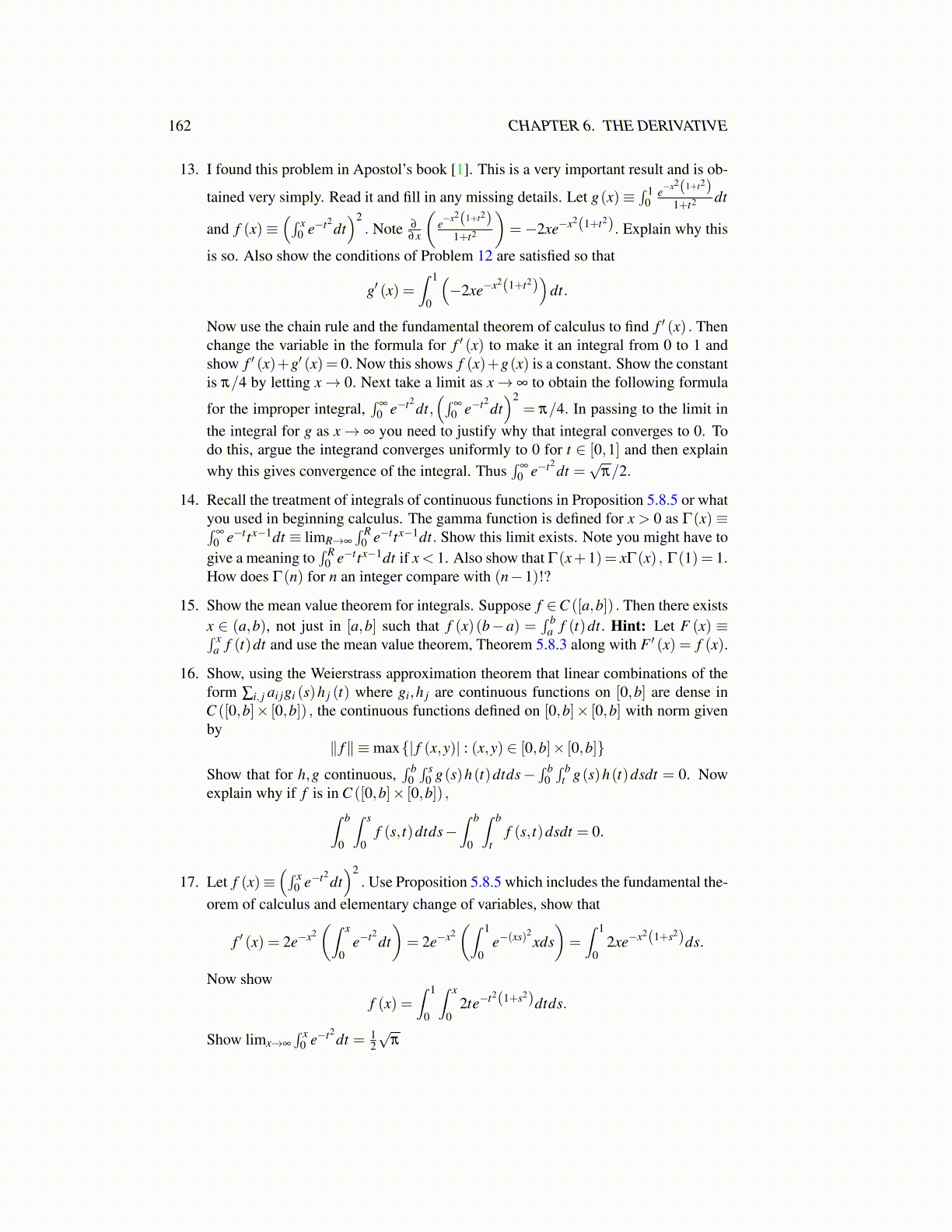
162 CHAPTER 6. THE DERIVATIVE
13. I found this problem in Apostol’s book [1]. This is a very important result and is ob-
tained very simply. Read it and fill in any missing details. Let g(x)≡∫ 1
0e−x2(1+t2)
1+t2 dt
and f (x)≡(∫ x
0 e−t2dt)2
. Note ∂
∂x
(e−x2(1+t2)
1+t2
)=−2xe−x2(1+t2). Explain why this
is so. Also show the conditions of Problem 12 are satisfied so that
g′ (x) =∫ 1
0
(−2xe−x2(1+t2)
)dt.
Now use the chain rule and the fundamental theorem of calculus to find f ′ (x) . Thenchange the variable in the formula for f ′ (x) to make it an integral from 0 to 1 andshow f ′ (x)+g′ (x) = 0. Now this shows f (x)+g(x) is a constant. Show the constantis π/4 by letting x→ 0. Next take a limit as x→ ∞ to obtain the following formula
for the improper integral,∫
∞
0 e−t2dt,(∫
∞
0 e−t2dt)2
= π/4. In passing to the limit inthe integral for g as x→ ∞ you need to justify why that integral converges to 0. Todo this, argue the integrand converges uniformly to 0 for t ∈ [0,1] and then explainwhy this gives convergence of the integral. Thus
∫∞
0 e−t2dt =
√π/2.
14. Recall the treatment of integrals of continuous functions in Proposition 5.8.5 or whatyou used in beginning calculus. The gamma function is defined for x > 0 as Γ(x)≡∫
∞
0 e−ttx−1dt ≡ limR→∞
∫ R0 e−ttx−1dt. Show this limit exists. Note you might have to
give a meaning to∫ R
0 e−ttx−1dt if x < 1. Also show that Γ(x+1) = xΓ(x) , Γ(1) = 1.How does Γ(n) for n an integer compare with (n−1)!?
15. Show the mean value theorem for integrals. Suppose f ∈C ([a,b]) . Then there existsx ∈ (a,b), not just in [a,b] such that f (x)(b−a) =
∫ ba f (t)dt. Hint: Let F (x) ≡∫ x
a f (t)dt and use the mean value theorem, Theorem 5.8.3 along with F ′ (x) = f (x).
16. Show, using the Weierstrass approximation theorem that linear combinations of theform ∑i, j ai jgi (s)h j (t) where gi,h j are continuous functions on [0,b] are dense inC ([0,b]× [0,b]) , the continuous functions defined on [0,b]× [0,b] with norm givenby
∥ f∥ ≡max{| f (x,y)| : (x,y) ∈ [0,b]× [0,b]}
Show that for h,g continuous,∫ b
0∫ s
0 g(s)h(t)dtds−∫ b
0∫ b
t g(s)h(t)dsdt = 0. Nowexplain why if f is in C ([0,b]× [0,b]) ,∫ b
0
∫ s
0f (s, t)dtds−
∫ b
0
∫ b
tf (s, t)dsdt = 0.
17. Let f (x)≡(∫ x
0 e−t2dt)2
. Use Proposition 5.8.5 which includes the fundamental the-orem of calculus and elementary change of variables, show that
f ′ (x) = 2e−x2(∫ x
0e−t2
dt)= 2e−x2
(∫ 1
0e−(xs)2
xds)=∫ 1
02xe−x2(1+s2)ds.
Now show
f (x) =∫ 1
0
∫ x
02te−t2(1+s2)dtds.
Show limx→∞
∫ x0 e−t2
dt = 12√
π